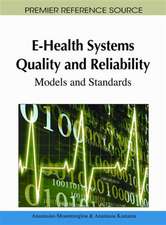Methods in Medical Informatics: Fundamentals of Healthcare Programming in Perl, Python, and Ruby: Chapman & Hall/CRC Computational Biology Series
Autor Jules J. Bermanen Limba Engleză Hardback – 22 sep 2010
Methods in Medical Informatics: Fundamentals of Healthcare Programming in Perl, Python, and Ruby demonstrates that biomedical professionals with fundamental programming knowledge can master any kind of data collection. Providing you with access to data, nomenclatures, and programming scripts and languages that are all free and publicly available, this book —
- Describes the structure of data sources used, with instructions for downloading
- Includes a clearly written explanation of each algorithm
- Offers equivalent scripts in Perl, Python, and Ruby, for each algorithm
- Shows how to write short, quickly learned scripts, using a minimal selection of commands
- Teaches basic informatics methods for retrieving, organizing, merging, and analyzing data sources
- Provides case studies that detail the kinds of questions that biomedical scientists can ask and answer with public data and an open source programming language
| Toate formatele și edițiile | Preț | Express |
|---|---|---|
| Paperback (1) | 376.15 lei 6-8 săpt. | |
| CRC Press – 18 sep 2018 | 376.15 lei 6-8 săpt. | |
| Hardback (1) | 1285.98 lei 6-8 săpt. | |
| CRC Press – 22 sep 2010 | 1285.98 lei 6-8 săpt. |
Din seria Chapman & Hall/CRC Computational Biology Series
-
 Preț: 346.48 lei
Preț: 346.48 lei - 9%
 Preț: 615.73 lei
Preț: 615.73 lei - 20%
 Preț: 389.57 lei
Preț: 389.57 lei -
 Preț: 357.22 lei
Preț: 357.22 lei -
 Preț: 357.97 lei
Preț: 357.97 lei -
 Preț: 357.69 lei
Preț: 357.69 lei -
 Preț: 357.16 lei
Preț: 357.16 lei - 9%
 Preț: 677.25 lei
Preț: 677.25 lei -
 Preț: 350.05 lei
Preț: 350.05 lei - 8%
 Preț: 528.20 lei
Preț: 528.20 lei - 20%
 Preț: 535.37 lei
Preț: 535.37 lei - 8%
 Preț: 407.01 lei
Preț: 407.01 lei -
 Preț: 370.11 lei
Preț: 370.11 lei - 8%
 Preț: 447.78 lei
Preț: 447.78 lei - 15%
 Preț: 699.14 lei
Preț: 699.14 lei - 22%
 Preț: 376.15 lei
Preț: 376.15 lei - 12%
 Preț: 305.97 lei
Preț: 305.97 lei -
 Preț: 422.44 lei
Preț: 422.44 lei - 5%
 Preț: 301.09 lei
Preț: 301.09 lei - 24%
 Preț: 702.77 lei
Preț: 702.77 lei - 15%
 Preț: 472.10 lei
Preț: 472.10 lei - 23%
 Preț: 492.08 lei
Preț: 492.08 lei - 15%
 Preț: 534.65 lei
Preț: 534.65 lei -
 Preț: 436.14 lei
Preț: 436.14 lei - 25%
 Preț: 529.77 lei
Preț: 529.77 lei -
 Preț: 455.01 lei
Preț: 455.01 lei - 18%
 Preț: 786.86 lei
Preț: 786.86 lei - 15%
 Preț: 468.17 lei
Preț: 468.17 lei - 20%
 Preț: 388.98 lei
Preț: 388.98 lei -
 Preț: 421.63 lei
Preț: 421.63 lei - 21%
 Preț: 1023.71 lei
Preț: 1023.71 lei - 25%
 Preț: 852.72 lei
Preț: 852.72 lei - 8%
 Preț: 305.97 lei
Preț: 305.97 lei - 22%
 Preț: 460.87 lei
Preț: 460.87 lei - 15%
 Preț: 557.60 lei
Preț: 557.60 lei - 15%
 Preț: 556.77 lei
Preț: 556.77 lei
Preț: 1285.98 lei
Preț vechi: 1568.27 lei
-18% Nou
Puncte Express: 1929
Preț estimativ în valută:
246.10€ • 256.61$ • 204.53£
246.10€ • 256.61$ • 204.53£
Carte tipărită la comandă
Livrare economică 20 martie-03 aprilie
Preluare comenzi: 021 569.72.76
Specificații
ISBN-13: 9781439841822
ISBN-10: 1439841829
Pagini: 416
Dimensiuni: 178 x 254 x 28 mm
Greutate: 0.84 kg
Ediția:New.
Editura: CRC Press
Colecția Chapman and Hall/CRC
Seria Chapman & Hall/CRC Computational Biology Series
ISBN-10: 1439841829
Pagini: 416
Dimensiuni: 178 x 254 x 28 mm
Greutate: 0.84 kg
Ediția:New.
Editura: CRC Press
Colecția Chapman and Hall/CRC
Seria Chapman & Hall/CRC Computational Biology Series
Public țintă
Professional Practice & DevelopmentCuprins
FUNDAMENTAL ALGORITHMS AND METHODS OF MEDICAL INFORMATICS: Parsing and Transforming Text Files. Utility Scripts. Viewing and Modifying Images. MEDICAL DATA RESOURCES: The National Library of Medicine’s Medical Subject Headings (MeSH ). The International Classification of Diseases. SEER: The Cancer Surveillance, Epidemiology, and End Results Program. OMIM: The Online Mendelian Inheritance in Man. PubMed. Taxonomy. Developmental Lineage Classification and Taxonomyof Neoplasms. U.S. Census Files. Centers for Disease Control and Prevention Mortality Files. PRIMARY TASKS OF MEDICAL INFORMATICS: Autocoding. Text Scrubber for Deidentifyin g Confidential Text. Web Pages and CGI Scripts. Image Annotation. Describing Data with Data, Using XML. MEDICAL DISCOVERY: Case Study: Emphysema Rates. Case Study: Cancer Occurrence Rates. Case Study: Germ Cell Tumor Rates across Ethnicities. Case Study: Ranking the Death-Certifying Process, by State. Case Study: Data Mashups for Epidemics. Case Study: Sickle Cell Rates. Case Study: Site-Specific Tumor Biology. Case Study: Bimodal Tumors. Case Study: The Age of Occurrence of Precancers. . Appendix. How to Acquire Ruby. How to Acquire Perl. How to Acquire Python. How to Acquire RMagick. How to Acquire SQLite. How to Acquire the Public Data Files Used in This Book. Other Publicly Available Files, Data Sets, and Utilities.
Notă biografică
Jules Berman, Ph.D., M.D., received two bachelor of science degrees (mathematics and earth sciences) from MIT, a Ph.D. in pathology from Temple University, and an M.D. from the University of Miami School of Medicine. His postdoctoral research was conducted at the National Cancer Institute. His medical residence in pathology was completed at the George Washington University School of Medicine. He became board certified in anatomic pathology and in cytopathology, and served as the chief of Anatomic Pathology, Surgical Pathology and Cytopathology at the Veterans Administration (VA) Medical Center in Baltimore, Maryland.
While at the Baltimore VA, Dr. Berman held appointments at the University of Maryland Medical Center and at theJohns Hopkins Medical Institutions. In 1998, he became the program director for pathology informatics in the Cancer Diagnosis Program at the U.S. National Cancer Institute. In 2006, he became president of the Association for Pathology Informatics. Over the course of his career, he has written, as first author, more than 100 publications, including five books in the field of medical informatics. Today, Dr. Berman is a full-time freelance writer.
While at the Baltimore VA, Dr. Berman held appointments at the University of Maryland Medical Center and at theJohns Hopkins Medical Institutions. In 1998, he became the program director for pathology informatics in the Cancer Diagnosis Program at the U.S. National Cancer Institute. In 2006, he became president of the Association for Pathology Informatics. Over the course of his career, he has written, as first author, more than 100 publications, including five books in the field of medical informatics. Today, Dr. Berman is a full-time freelance writer.
Recenzii
As subspecialty board certification in clinical informatics has finally become a reality, Jules Berman’s Methods in Medical Informatics could not be more timely. This well-written and informative text combines Dr. Berman’s expertise in programming with his vast knowledge of publicly available data sets and everyday healthcare programming needs to result in a book which … should become a staple in health informatics education programs as well as a standard addition to the personal libraries of informaticists.
—Alexis B. Carter, Journal of Pathology Informatics, October 2011
This book provides an introduction to processing clinical and population health data using rigorous methods and widely available, low cost, but very capable tools. The inclusion of the three leading dynamic programming languages broadens the appeal … bridges the gap from programming instruction to dealing with specialized medical data, making it possible to teach a relevant programming course in a biomedical environment. I would have loved to have a copy of this when I was teaching introductory programming for medical informatics.
—Professor James H. Harrison, Jr., Director of Clinical Informatics, University of Virginia
… presents students and professionals in the healthcare field (who have some working knowledge of the open-source programming languages Perl, Python, or Ruby) with instruction for applying basic informatics algorithms to medical data sets. He [the author] provides algorithm scripts for each of the languages, along with step-by-step explanations of the algorithms used for retrieving, organizing, merging, and analyzing such data sources as the National Cancer Institute’s Surveillance Epidemiology and End Results project, the National Library of Medicine’s PubMed service, the mortality records of the US Centers for Disease Control and Prevention, the US Census, and the Online Mendelian Inheritance in Man data set on inherited conditions.
—SciTech Book News, February 2011
—Alexis B. Carter, Journal of Pathology Informatics, October 2011
This book provides an introduction to processing clinical and population health data using rigorous methods and widely available, low cost, but very capable tools. The inclusion of the three leading dynamic programming languages broadens the appeal … bridges the gap from programming instruction to dealing with specialized medical data, making it possible to teach a relevant programming course in a biomedical environment. I would have loved to have a copy of this when I was teaching introductory programming for medical informatics.
—Professor James H. Harrison, Jr., Director of Clinical Informatics, University of Virginia
… presents students and professionals in the healthcare field (who have some working knowledge of the open-source programming languages Perl, Python, or Ruby) with instruction for applying basic informatics algorithms to medical data sets. He [the author] provides algorithm scripts for each of the languages, along with step-by-step explanations of the algorithms used for retrieving, organizing, merging, and analyzing such data sources as the National Cancer Institute’s Surveillance Epidemiology and End Results project, the National Library of Medicine’s PubMed service, the mortality records of the US Centers for Disease Control and Prevention, the US Census, and the Online Mendelian Inheritance in Man data set on inherited conditions.
—SciTech Book News, February 2011
Descriere
A user friendly, step-by-step practical guide for applying basic informatics algorithms to medical data sets, this book includes examples using Perl, Python, and Ruby. The author employs a minimal selection of commands for quick learning, and references only free, publicly available resources. This book demonstrates how easy it is to master the wide variety of data types encountered in a healthcare setting with just a few simple programming commands. It covers building blocks, medical data resources, primary tasks of medical informatics, and medical discovery.



















